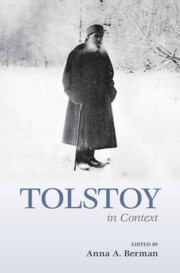Book contents
- Tolstoy in Context
- Tolstoy in Context
- Copyright page
- Contents
- Figures
- Notes on Contributors
- Preface
- Acknowledgments
- Note on Citations, Translations, and Transliterations
- Chronology
- Part I The Man
- Part II Russian Social and Political Contexts
- Chapter 5 Peasants and Folklore
- Chapter 6 The Great Reforms
- Chapter 7 Nobility and the Russian Class System
- Chapter 8 The Russian Orthodox Church
- Chapter 9 Law
- Chapter 10 Politics
- Chapter 11 War and the Military
- Chapter 12 Tolstoyans
- Chapter 13 Clothing
- Chapter 14 The “Woman Question”
- Chapter 15 The Family
- Part III Literature, the Arts, and Intellectual Life
- Part IV Science and Technology
- Part V Beyond Russia
- Part VI Tolstoy’s Afterlife
- Suggested Further Reading
- Index
Chapter 7 - Nobility and the Russian Class System
from Part II - Russian Social and Political Contexts
Published online by Cambridge University Press: 05 January 2023
- Tolstoy in Context
- Tolstoy in Context
- Copyright page
- Contents
- Figures
- Notes on Contributors
- Preface
- Acknowledgments
- Note on Citations, Translations, and Transliterations
- Chronology
- Part I The Man
- Part II Russian Social and Political Contexts
- Chapter 5 Peasants and Folklore
- Chapter 6 The Great Reforms
- Chapter 7 Nobility and the Russian Class System
- Chapter 8 The Russian Orthodox Church
- Chapter 9 Law
- Chapter 10 Politics
- Chapter 11 War and the Military
- Chapter 12 Tolstoyans
- Chapter 13 Clothing
- Chapter 14 The “Woman Question”
- Chapter 15 The Family
- Part III Literature, the Arts, and Intellectual Life
- Part IV Science and Technology
- Part V Beyond Russia
- Part VI Tolstoy’s Afterlife
- Suggested Further Reading
- Index
Summary
This chapter situates Lev Tolstoy’s life and work in relation to the social and political context of the estates (meaning, soslovie) system in imperial Russia. Although the Russian nobility was a social estate distinguished by a high degree of heterogeneity when it came to such matters as scope of property (including income and debt), modes of sociability, access to power, relationship to the provinces, and connection to the cultural and political centers (e.g., Moscow, St. Petersburg), the nobility remained a corporate body of subject-citizens united through a necessarily uneven but reciprocal relationship with the autocratic state, a relationship that was articulated as a set of privileges and obligations. In addition to offering a brief historical survey of the noble estate in Russia, this chapter explores a selection of moments in Tolstoy’s life and career in relation to the meanings that accrued to noble status as a demographic designation, a political experience, and a social performance. At times, I turn (briefly) to Tolstoy’s major works of fiction (notably, War and Peace and Anna Karenina) to illustrate how the period’s definitions of nobility found expression in the novelist’s artistic imagination.
- Type
- Chapter
- Information
- Tolstoy in Context , pp. 54 - 60Publisher: Cambridge University PressPrint publication year: 2022

